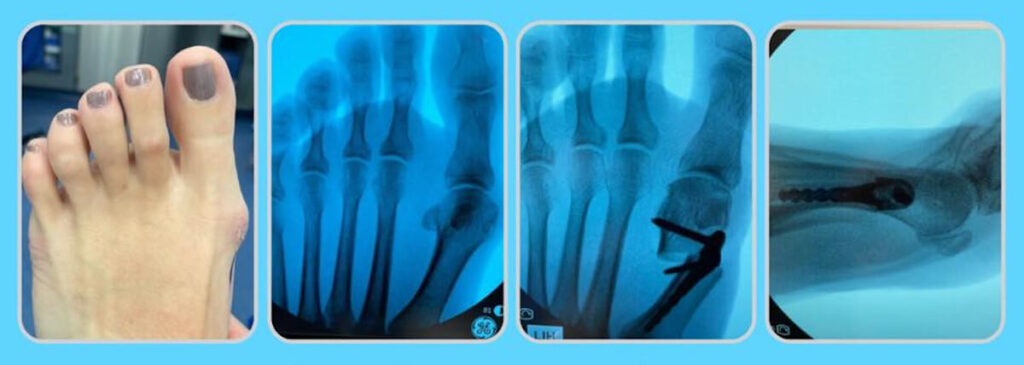
Bunions
Bunion Surgery & Treatment In Brooklyn
A bunion is a misalignment of the bones at the base of the big toe. The joint at the base of the big toe is known as the metatarsophalangeal joint (MTP joint). In a normal MTP joint, the big toe will point straight ahead. When the bones in the MTP joint become misaligned, the big toe will lean or point inward toward the other toes, forming a lump on the side of the MTP joint.
A bunion occurs when too much pressure is placed on the big toe and it’s supporting structure is progressively forced out of it’s natural position. As a bunion progresses the big toe will drift inward, which can cause further complications.
Risk Factors & Symptoms
Common risk factors and causes of bunions can include:
- Genetics – an inherited foot structure defect
- Footwear – tight fitting dress shoes and high heels
- Arthritis – osteoarthritis, rheumatoid arthritis
This condition most commonly occurs in middle-aged adults. Women are more likely than men to develop bunions, which is attributed to footwear choices.
Besides a lump on the side of the MTP joint, symptoms of bunion include:
- Pain
- Tenderness
- Redness
- Inflammation
- Limited Motion (Big Toe)
As the misalignment of the MTP joint progresses, corns and calluses may develop between the toes when pressure from the big toe causes them to rub against each other.
Pain on side of the MTP joint is a very common symptom and can be aggravated by stiff and tight footwear. Pain will worsen as the condition progresses.
Conservative Bunion Treatment
Pain can worsen if this condition is not treated, so it’s important to have your foot examined by a podiatrist. The earlier this condition is treated, the more likely a patient will benefit from non-operative treatment. If the deformity isn’t severe, changes related to footwear may be enough to reduce discomfort.
Non-operative treatments for bunions can include:
- Activity Modification
- Anti-Inflammatory Medication
- Wider, Low Profile Footwear
- Ice (Cold Packs)
- Bunion Pads
- Custom Orthotics
Surgery to realign and repair the MTP joint is only recommended if non-operative treatments fail to reduce pain to a manageable level. There is more than one surgical procedure for a bunion deformity. A foot surgeon will determine and explain the type of procedure to be used. Most procedures are done on an outpatient basis
Surgical Treatment For Bunions
Surgery to realign and repair the MTP joint is a last resort, but may needed to correct the bunion if non-operative treatments fail to reduce pain to a manageable level.
A surgical procedure to correct bunions may done using traditional open techniques or as a minimially-invasive procedure. The severity of bunions, additional complications, and other factors will determine which type of surgical techniques should be used to produce the best possible result. A severe bunion may require aggressive surgical techniques .Your foot surgeon will determine and discuss which type of procedure is the best for your disorder. Most procedures are done on an outpatient basis.
When surgery is indicated, most bunion patients will be candidates for a minimally-invasive procedure (percutaneous bunionectomy). Benefits of a minimally-invasive procedure includes a faster recovery and less post-surgical pain than a traditional open procedure.
Minimally invasive surgical techniques and implants (hardware) have advanced significantly in recent years. These advancements have enabled bunion surgery patients to recovery at a much faster rate than in the past. In some cases, patients can start to bear weight immediately after surgery (with the use of a postoperative shoe).
One of the most popular and successful minimally invasive techniques to correct bunions is known as the miniBunion® 3D surgery technique.
MiniBunion® Surgery
The minibunion® 3D procedure requires a tiny incision made on the inner side of foot. A foot surgeon that make small cuts in the bone using surgical instrumentation and aligns it in all 3 dimensions. The realigned bone is than secured with the minibunion® implant. After the implants is secured, the incision is closed using a suture.
The minibunion® 3D procedure involves a minimal amount of trauma to the metatarsophalangeal joint and soft tissue. The minibunion® implant is designed to provide immediate stability to the patient’s foot with minimal scarring. Post-operative pain is significantly less than what is expected after a traditional open bunionectomy. The result is that most patient’s will be able walk during the recovery period while wearing a postoperative shoe.
The minibunion® 3D procedure is classified as a bunion correction procedure, which means it is covered by most health insurance companies.

Board-Certified Podiatrist In Brooklyn
Our podiatrist are highly experienced at diagnosing and treating painful disorders that affect the foot.
Bunions, gout, and osteoarthritis are all conditions that should be managed as early as possible to prevent or slow down the progression of damage to the metatarsophalangeal joint.
Make an appointment in Brooklyn with one of board-certified foot doctors to have your condition evaluated and discuss the best methods of treatment.


